Spiced, savory, and heartwarming, this vegetarian biryani rice is the kind of rice dish that lingers in the kitchen and in your heart, a good balance of tradition and personal flavor.
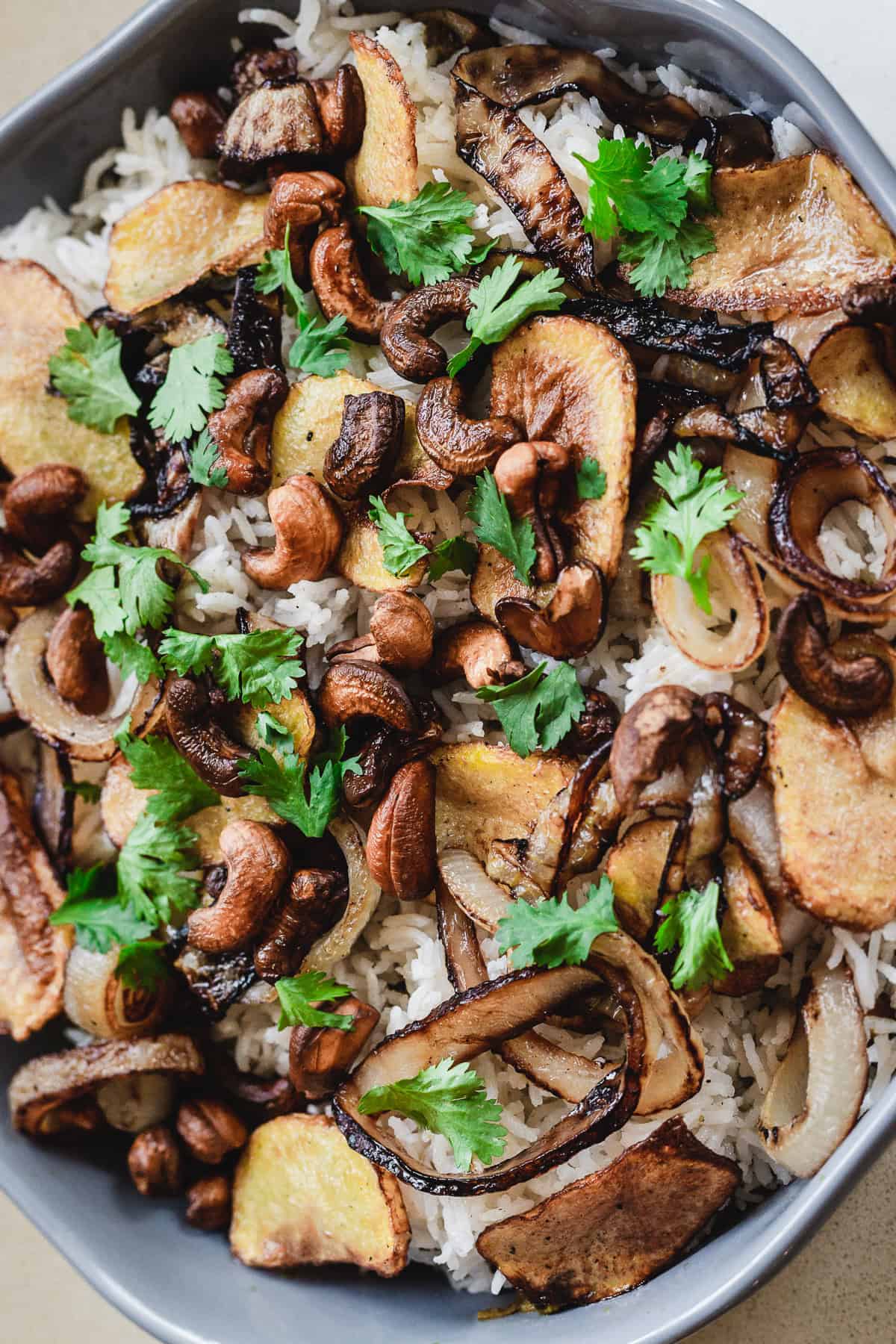
Some days, I find myself reaching for basmati rice the way others reach for comfort. There’s something about the way it absorbs warmth, the way each grain holds onto aromatic depth, the way it lingers on the stove, waiting to be shaped into something familiar.
When Passover comes around, when the house is busy with preparations and the table fills with family, I think about the meals that have traveled with us. Across generations, across continents.
And I think about Einav. Einav and I have been friends for what feels like a lifetime, though we now live in different places, our lives unfolding in parallel but separate rhythms. She’s in Israel usually, but in Toronto these days, while I’m here, in Montreal, but when we talk, it’s as if no time has passed.
We send each other recipes like love notes, little reminders of the meals we used to share, the ones we still make, even an ocean apart. It’s crazy to see where we both ended up, how we’re raising our kids in different parts of the world, how our kitchens are filled with the same scents.
Her family came from Pura and Bombay, bringing with them the spices of their past. And every once in a while, she makes a big veg biryani: fragrant with cumin and coriander, layered with vegetables, studded with sweet dates.
And I've adopted her recipe, making it for our family's special occasions. It’s not what most expect on a table in a Russian-Colombian-Jewish house, but that’s what I love about it. Biryani is a rice dish that evolves. Tradition isn’t static, it stretches, it adapts, it becomes something personal.
A Recipe That Surpasses Countries

It reminds me of the first time I had mujadara. Humble, rich, the sweetness of onions melting into earthy lentils, each bite deeper than the last. Every culture has a dish like that, one that feels like home no matter where you are. I didn’t grow up with samosas either, but Einav always spoke of them at her family gatherings, crisp and golden, tucked between platters, filled with spiced potatoes and peas. She was the first one to introduce me to okra curry, to make it fall in love with the Indian way of making it.
Now, as I layer the biryani rice, I think of those flavors mingling, deepening with time, the scent of crisping onions curling into the air. It’s the same quiet comfort, the kind that travels through memory, across oceans, and back into the kitchen.
When the rice is ready, I lift the lid, letting the steam rise, carrying with it the scent of turmeric and cinnamon, of places I’ve been and places I have yet to go. I think about how Einav is probably making this too, in her own kitchen, at her own table. How even though we are far apart, this meal is something we still share.
And maybe that’s what matters most. Not just the food itself, but the way it ties us to each other. A way to bridge the distance, to share something even when we’re worlds apart. The same spices blooming in oil, the same slow simmer, the same quiet pause before the first bite. A taste that lingers like memory. The warmth of rice. The silent understanding that some friendships, like the meals we return to, never fade.
Ingredients

For the Biryani Spice Blend
- Cumin, Coriander, Cardamom, Cinnamon, Cloves, Black Pepper, Nutmeg, Turmeric - This homemade blend brings warmth, sweetness, and depth. A layer of flavorful complexity that blooms as the dish cooks. If you’re short on time, a store-bought biryani mix works too, but making it from scratch gives the dish that personal, from-your-own-kitchen touch.
For the Vegetable Curry
- Chickpea Flour - This is what thickens the curry and gives it a nutty edge. It also makes the dish naturally gluten-free. If you don’t have it, a tablespoon of cornstarch can work, but the flavor won’t be the same.
- Zucchini & Mushrooms - I go for smaller zucchinis, sliced into half-moons, and cremini mushrooms when I can find them. They soak up the spices beautifully. Feel free to swap in eggplant, carrots, or green beans depending on what you have. This part is flexible, just make sure to keep the volume the same.
- Medjool Dates - Sweet, soft, and rich, these are the heart of the dish. They add unexpected depth and balance all the spices. I used to think they were just for snacking until Einav showed me how her mom folded them into biryani. Trust me, don’t skip them. Deglet Noor can work, but they’re firmer and less caramel-like.
For the Topping
- Cashews - Toasted until golden and buttery. I always add these last minute, just before serving. They’re optional, but they make the whole dish feel celebratory. Slivered almonds can be subbed in if you prefer a crunchier texture.
For the Rice
- Basmati Rice - Long-grain basmati is essential, it stays fluffy and separate. Perfect for layering. I rinse mine a few times before cooking, a trick I learned from watching Einav’s aunt, who swore it helped the grains stay distinct. Don’t skip this step.
For Garnish
- Fresh Cilantro - If you’re not a cilantro fan, a handful of fresh parsley will work in a pinch, though the flavor won’t be as layered.
See the recipe card for full list and exact quantities.
How to Make This Vegetable Biryani Rice

This vegetarian biryani rice recipe is fragrant, comforting, and perfect for Passover or any gathering that calls for something special but unfussy. With layers of spiced vegetables, fluffy basmati rice, sweet dates, and crispy toppings, it’s a dish that tastes like it came from somewhere far away, yet, it feels like home. Here’s how to make this recipe:
Prepare the Rice
Rinse the basmati rice several times under cold water until the water runs clear. This step keeps the rice from becoming sticky later. Soak the rinsed rice for 20 minutes, then drain.
Bring 4 cups of water to a boil in a large pot. Add the soaked rice and salt. Cook until the rice is about 90% done, soft on the outside with a slight bite in the center (this takes around 8–10 minutes). Drain the rice and set it aside.
Cook the Vegetable Curry


In a large pot, heat 2 tablespoon oil over medium heat. Sauté chopped onion until translucent, 3–4 minutes. Add garlic and cook for 1 minute. Stir in mushrooms and zucchini. Cook for about 10 minutes, until soft and lightly golden.
Spice It Up and Simmer



Add 1 teaspoon biryani spice blend, curry powder, ginger, and coconut powder. Stir for 30 seconds. Add chickpea flour and stir for 1–2 minutes to toast. Mix in chopped dates. Pour in 2 1⁄2 cups of water, just enough to cover vegetables. Simmer for 10–15 minutes until tender and the sauce thickens. Season with salt.
Make the Biryani Spice Blend

If you’re preparing your own spice mix, combine all the spices listed under the Biryani Spice Blend in a small bowl. Mix well, then set aside. Any leftovers can be stored in an airtight jar for future biryani nights.
Make the Toppings


While the curry simmers, heat remaining oil in a pan. Fry onion rings until golden and crisp, 5–7 minutes. Set on paper towel.
In the same pan, fry potato slices until golden and tender, about 4–5 minutes. Toast cashews last, 2–3 minutes until golden. Keep an eye on them, they burn fast!
Assemble the Biryani



In a large baking dish, layer half the cooked rice. Spoon over all the vegetable curry. Top with the remaining rice.
Add Toppings


Scatter fried onions, potatoes, and toasted cashews on top. Finish with chopped cilantro.
Final Touch
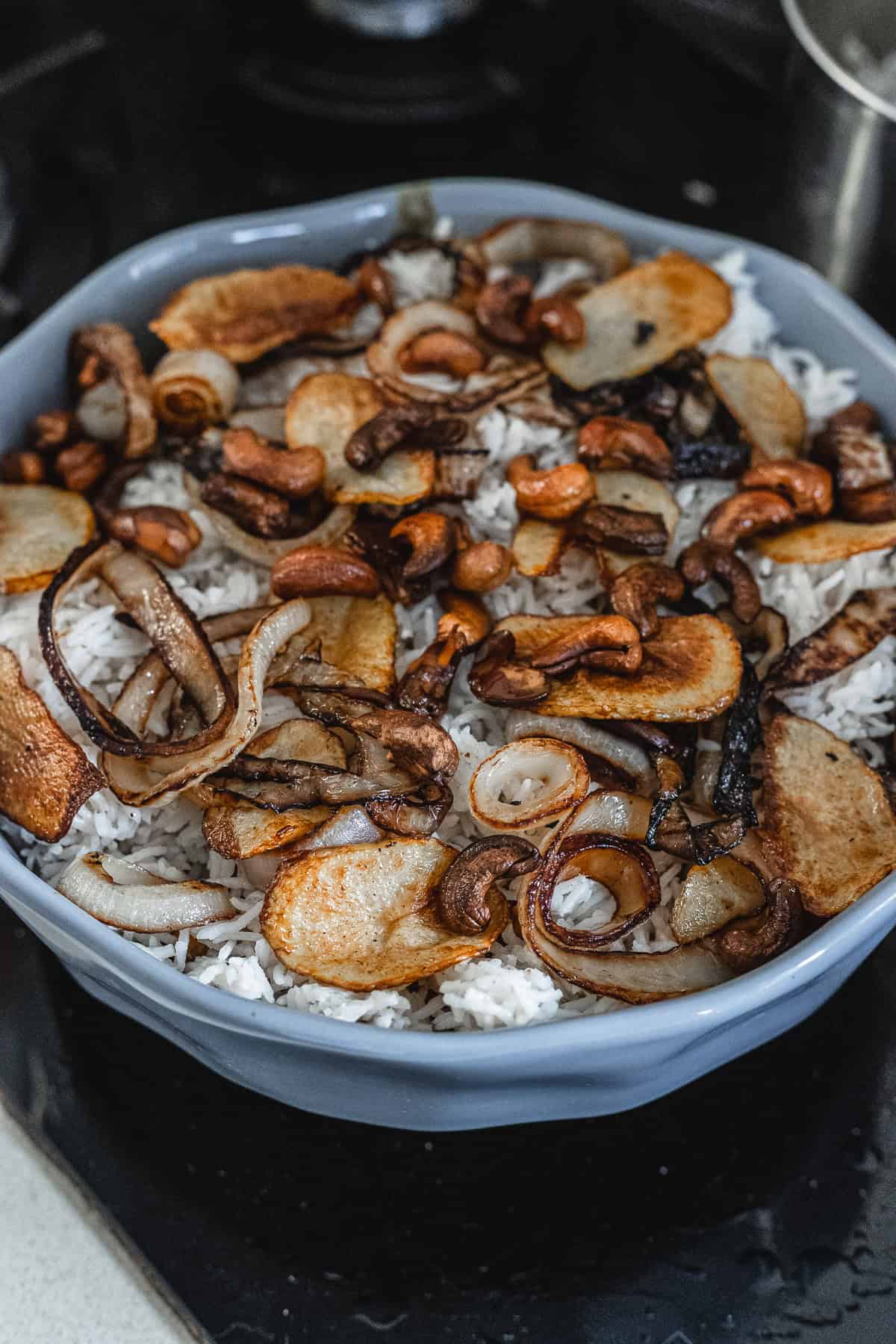
Cover the dish with foil and warm in a 350°F (175°C) oven for about 10 minutes, or serve immediately as is.
Storage
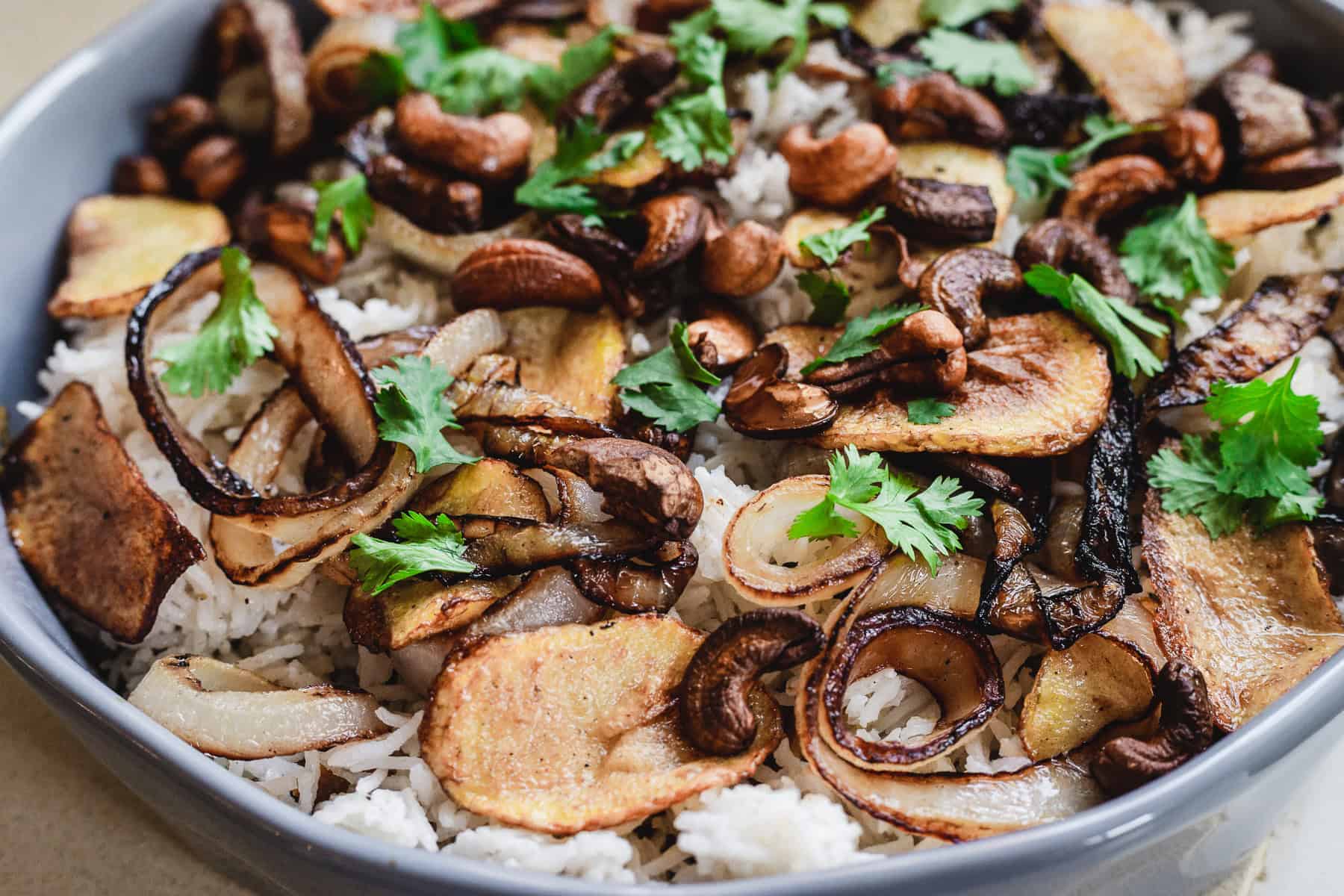
Once your vegetarian biryani rice is layered, topped, and served, you might find yourself with leftovers, especially if you’ve made it for a holiday table. I like to pack them into a wide, shallow container so the toppings stay crisp and the rice doesn’t get too compressed. Stored this way, it keeps beautifully in the fridge for up to 4 days.
If you want to freeze it, skip the crispy toppings (they lose their charm in the freezer). Just layer the rice and curry, let it cool completely, and freeze in an airtight container for up to a month. Reheat gently in the oven or on the stovetop with a splash of water to loosen things up. It won’t be exactly like the first day, but it’ll still taste like something made with care.
Top Tips
Soak First, Always – don’t skip the soak! Letting the rice sit in water for 20 minutes helps it cook evenly and stay fluffy. I usually rinse and soak the rice first thing, then prep the vegetables while it rests. It’s a small step that makes a big difference.
Chickpea Flour Magic – cooking the chickpea flour before adding water is key. I learned this the hard way once, I skipped that step and ended up with a slightly raw, gritty curry. Toasting it for a minute or two brings out its nutty flavor and helps it thicken the sauce smoothly.
What to Serve with this Vegetable Biryani Recipe

This fragrant biryani is a dish that brings people together, and I love pairing it with something that offers a bit of contrast. A Middle Eastern Quinoa Salad is a go-to for me, its bright herbs and citrusy dressing provide a refreshing bite that balances the warmth of the rice. If I’m craving something a bit more hearty, I’ll go for a hearty Gluten-Free Vegetarian Moussaka. The creamy, comforting layers of eggplant and béchamel sauce work beautifully with the spiced rice, creating a cozy, filling meal.
For something lighter, I’ll serve it with German Roasted Cauliflower, with its crispy edges and simple flavors that complement the biryani without competing with it. And if I’m in the mood for something more adventurous, I’ll add an Uzbek Chicken Plov to the mix, its deep flavors and tender chicken pair so well with the biryani, offering a meal that feels like a warm hug from every direction.
Recipe
Tried and loved this recipe? Please leave a 5-star review below! Your reviews mean a lot to me, so if you've got any questions, please let me know in a comment.
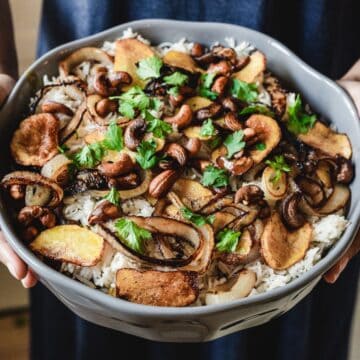
Vegetarian Biryani Rice
Equipment
Ingredients
For the Biryani Spice Blend
- 1 tablespoon ground cumin
- 1 tablespoon ground coriander
- 1 teaspoon ground cardamom
- 1 teaspoon ground cinnamon
- ½ teaspoon ground cloves
- ½ teaspoon ground black pepper
- ¼ teaspoon ground nutmeg
- 1 teaspoon ground turmeric
For the Vegetable Curry
- 1 large onion chopped
- 4 garlic cloves minced
- 1 teaspoon biryani spice blend from above or store-bought
- 1 teaspoon curry powder
- ½ teaspoon ground ginger
- ½ teaspoon coconut powder
- 3 tablespoon chickpea flour
- 1 pound mushrooms sliced
- 10 Medjool dates pitted and chopped
- 2½ cups water or as needed
- salt to taste
For the Topping
- 1 medium onion thinly sliced into rings
- 1 medium potato thinly sliced
- ½ cup cashews
- 3 tablespoon vegetable oil for frying
For the Rice
- 2 cups basmati rice
- 4 cups water
- 1 teaspoon salt
For Garnish
- ¼ cup fresh cilantro chopped
Instructions
- If making your own, combine all the spice blend ingredients in a small bowl. Stir well and set aside. Any leftover spice blend can be stored in an airtight container for later use.
- Rinse the basmati rice several times under cold water until the water runs clear. Soak the rice for 20 minutes, then drain.
- Bring 4 cups of water to a boil in a pot. Add the drained rice and salt. Cook the rice until it's about 90% done, soft on the outside but still slightly firm in the center (about 8-10 minutes). Drain and set aside.
- In a large pot, heat 2 tablespoons of oil over medium heat. Add the chopped onion and sauté for 3-4 minutes until translucent.
- Add the minced garlic and cook for 1 minute, letting it become fragrant.
- Stir in the sliced mushrooms and zucchini. Cook for 10 minutes until softened and lightly golden.
- Add the biryani spice blend, curry powder, ground ginger, and coconut powder. Stir for 30 seconds to toast the spices.
- Add the chickpea flour, stirring constantly for 1-2 minutes to prevent lumps.
- Pour in 2½ cups of water (or enough to cover the vegetables). Bring to a simmer and cook until the vegetables are tender, about 10-15 minutes. Add salt to taste.
- While the curry simmers, heat the remaining oil in a separate pan. Fry the sliced onion rings for 5-7 minutes until golden and crispy, then remove and set aside.
- In the same oil, fry the potato slices for 4-5 minutes until golden and cooked through. Remove and set aside.
- Toast the cashews in the remaining oil for 2-3 minutes until golden, then set aside.
- In a large baking dish, spread half of the cooked rice as the bottom layer. Pour the vegetable curry with its sauce over the rice.
- Add the remaining rice as the top layer. Arrange the fried onions, potato slices, and toasted cashews on top. Sprinkle with fresh chopped cilantro.
- Cover the dish with foil and heat in a 350°F (175°C) oven for 10 minutes. Alternatively, serve immediately for a freshly made dish.




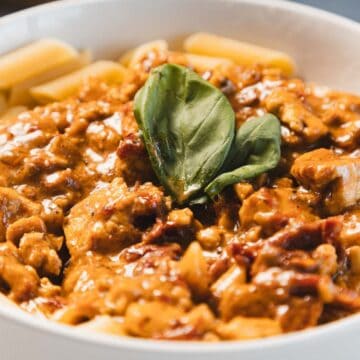
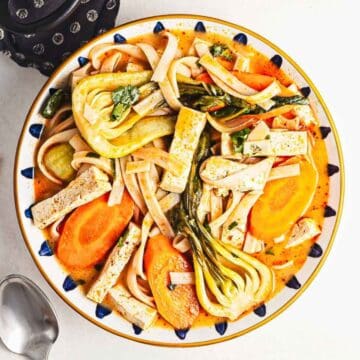

Tell Me What You Think!